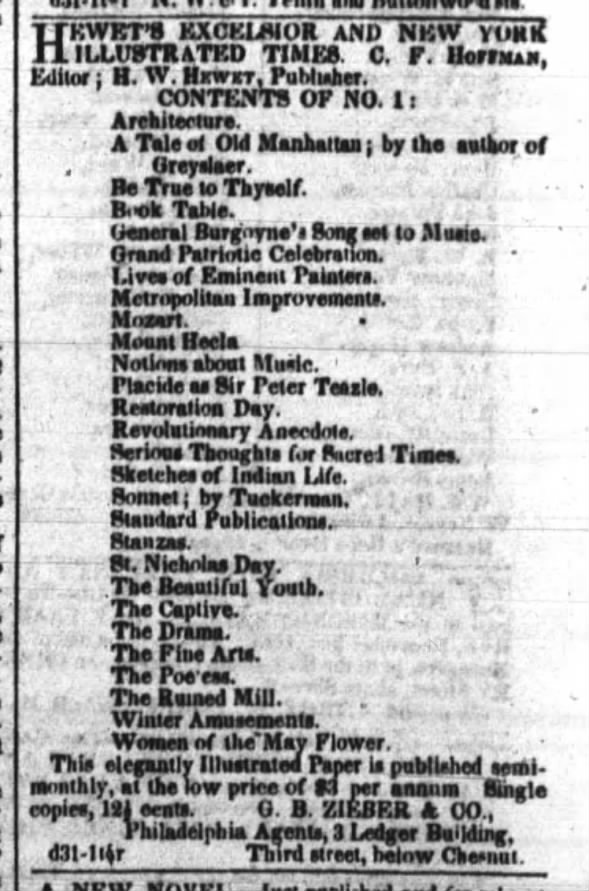Alfred Billings Street, again. Charles Fenno Hoffman called Albany's forgotten poet Alfred B. Street "the Teniers of American poets" in the short lived Excelsior. In the same vein, reviewing the same 1845 volume The Poems of Alfred B. Street, Henry T. Tuckerman in the United States Magazine and Democratic Review praised his Albany friend as "a true Flemish painter." So then: two friendly critics of Alfred B. Street's 1845 Poems, both of whom would become friends of Melville's, compared Street and his authentic verse descriptions of nature to Flemish painters and their style of genre painting --thirty years before Melville likened Street's poem The Old Garden to
"a flower-and-fruit piece by some mellow old Fleming." --Herman Melville's Correspondence, ed. Lynn Horth (Evanston and Chicago: Northwestern University Press and The Newberrry Library, 1993), page 463.

Hewet's Excelsior and New York Illustrated Times was conceived as an American version of the London Illustrated Times. Editor Charles Fenno Hoffman's generous (though qualified) estimation of Street's poetry was reprinted in the March 1846 Knickerbocker:
WE were about to indite a short review of our esteemed friend and correspondent's very beautiful volume, when the following notice of the same work, from the capable pen of Mr. C. F. Hoffman, in 'Excelsior,’ (a most gentlemanly journal, 'too early lost,') met our eye, and we at once decided that we could do nothing half so felicitous as to say 'ditto to Mr. BURKE,' and make the notice 'ours by adoption:'
“Mr. STREET is the TENIERS of American poets. Perfect in his limited and peculiar range of art, as is LONGFELLOW in his more extended and higher sphere, STREET is the very daguerreotype of external nature. And yet his portraits are not mere mechanical copies of her features, so much feeling as well as truth is there in his microscopic delineations. He has not indeed the fervid minstrel power of WHITTIER ; the high meditative philosophy of BRYANT; the fine lyric inspiration of HALLECK; the beautiful and luminous sentiment of LONGFELLOW; nor is there the vivid creative power, the sparkling fancy and impassioned grace, which divided among some of our female poets, is as yet blended upon the page of neither sex, in our still nursing literature. Yet that characteristic still remains to him, without which all these others are as nothing; and which, possessed to the full degree in which it fills the soul of Street, makes him a true poet; namely, feeling—an intense feeling and appreciation of his subject; a devotion like that of a lover to his mistress; a love for nature unaffected, enthusiastic, unceasing; a love vigilant as a mother's for her offspring; reverential as that of a child for its parent. He watches her every look and feature, with no end save the tender delight of thus watching; he worships her every expression, with no motive save the gratification of his full feeling of homage. And if the issues of social life chance at times to blend with the accidents of his theme, the flow of inspiration from such sources is wholly subordinate to the natural tides of his song. With the pedantic or superficial reader, Street might still be left as the maker of mere descriptive verses, which had no merit save a kind of Chinese fidelity to purely physical realities; but he who, impelled by the true love of Nature, shall look more curiously into his song, will find STREET's poetry, like the face of the divinity herself, full of suggestiveness. As an instance of this, we may mention that we have before us an illustrated London publication, in which one of his poems (regarded by matter-of-fact people here as characteristically matter-of-fact,) has suggested to a spirited artist two of the most striking sketches that the season has produced." --The KnickerbockerBelow, contents of the first number of Hewet's Excelsior and New York Illustrated Times, as advertised in the Philadelphia Public Ledger on New Year's Eve, 1845:
 · Wed, Dec 31, 1845 – Page 2 · Public Ledger (Philadelphia, Pennsylvania) · Newspapers.com
· Wed, Dec 31, 1845 – Page 2 · Public Ledger (Philadelphia, Pennsylvania) · Newspapers.com Related post:


No comments:
Post a Comment